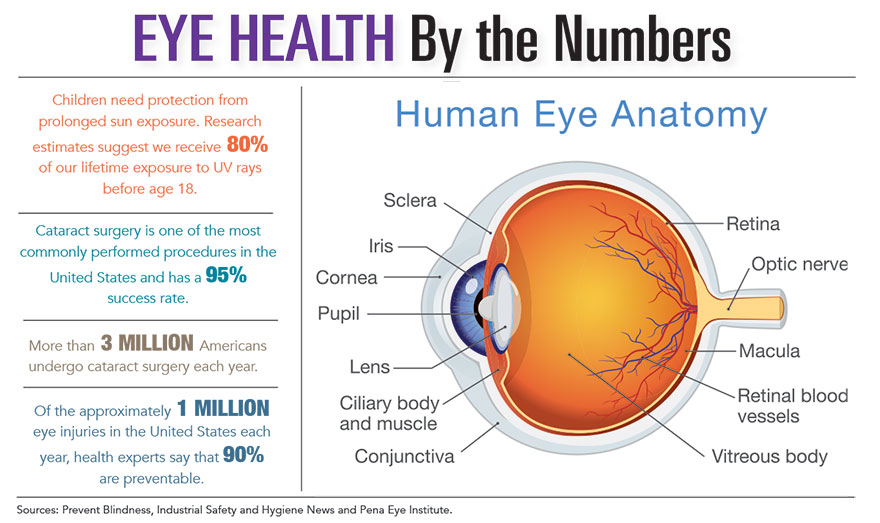A comprehensive eye exam is an important part of preventive eye care, helping identify vision problems that may need treatment and as an overall health indicator. So how often should you schedule one?
Dr. Kerry Solomon, M.D., an internationally renowned cataract, LASIK and advanced vision correction specialist and board-certified ophthalmologist with Carolina Eyecare Physicians in Charleston, said it is a good idea for most people to get a comprehensive eye exam once per year.
Dr. Samuel Johansen, O.D., of Johansen Precision Eye Care in Greenwood, added that the frequency of when comprehensive eye exams are needed varies by certain age and risk factors. For youngsters, the American Optometric Association recommends an eye exam by age 1 in order to screen for eye conditions such as retinoblastoma, an eye cancer found in children.
By age 2 or 3 years, he said, kids should have an eye exam annually to help diagnose and treat vision issues early. For adults who require glasses, an exam is advised every year, while adults with no vision problems should get checked biennially. Adults older than 50 need to schedule an annual exam. People with diabetes should get an exam at least once a year because examining blood vessels of the retina can help determine whether blood sugar levels are too high, which, if uncontrolled, can lead to blurry vision or more significant eye damage.
Protection from the sun’s rays
As much as you would apply sunscreen to shield your skin from burns, precautionary measures are advised to prevent harmful ultraviolet rays from damaging your eyes if you are planning a full day of outdoor activity. Being outside in the summertime heat in general can cause drying of the eyes, noted Dr. Solomon. Redness is one indication that your eyes are drying out. He suggested using lubricating drops or artificial tears to avoid this issue.
Dr. Solomon and Dr. Johansen both recommended wearing sunglasses with UV filtration to protect your eyes during beach, golf or boating excursions.
For people working outside jobs such as construction or coaching sports, wearing UV filtration glasses could provide a critical safeguard against the early onset of cataracts, said Dr. Johansen.
UV sunglasses also protect against macular degeneration, which happens when a portion of your retina is damaged, causing blurred or reduced vision. People with blue eyes are at higher risk for macular degeneration because their eyes are more light-sensitive, whereas brown eyes allow less light through. It is also important for children to wear sunglasses, since the younger you are, the larger your pupils, and bigger pupils allow more light to get through, remarked Dr. Johansen.
Advances in LASIK
If you suffer from common vision problems, LASIK is a corrective treatment option to consider.
LASIK surgery treats eye problems such as nearsightedness, farsightedness and astigmatism.
“It corrects issues that require people to wear glasses and contacts,” stated Dr. Solomon, South Carolina’s leading LASIK surgeon.
LASIK – laser-assisted in situ keratomileusis – which uses a laser to reshape the cornea and make vision clearer, is now not only more accurate and quicker, it’s a much safer procedure as well, explained Dr. Solomon. There are no blades and no cutting. Risk factors for LASIK are lower than those of contacts.
“It has come so far in the past 10 to 15 years,” observed Dr. Solomon.
Most people who get LASIK surgery are done in 10 minutes and find that their vision has improved that same day.
“It doesn’t slow you down,” said Dr. Solomon, adding that LASIK success rates are high, with half of patients seeing 20/20 and half seeing even better.
The first person to perform LASIK in South Carolina, Dr. Solomon has been on the forefront of cutting-edge research and technological advances. One major development is topography-guided LASIK, in which you can smooth out irregular corneas. Dr. Solomon was the first surgeon in the country to perform this procedure.
The newest LASIK method is ray tracing, which is currently undergoing Food and Drug Administration trials. It has the potential to improve not only LASIK accuracy but its quickness as well. The surgery is designed for someone who wears glasses or contacts and is interested in being less dependent on them. It can allow people to see better than 20/20 vision, Dr. Solomon asserted.
Cataracts: signs and treatments
June was Cataract Awareness Month; knowing cataract symptoms is useful information since vision loss from cataracts can be restored.
“Cataracts are age-related typically,” commented Dr. Johansen, pointing out that they generally appear between ages 55 and 65. Cataracts occur when the lens inside your eye gradually turns cloudy.
While cataracts do not physically harm you, they impairs your vision and quality of life, making your everyday routine a challenge, noted Dr. Solomon, a research leader and pioneer in the field of advanced cataract and refractive surgeries.
Warning signs are blurred vision, glare and halos at night and difficulty in seeing contrast in colors.
There are numerous visual options for patients who have cataracts, including cataract surgery, which can be performed quickly and with a high success rate. No needles or stitches are required, and you go home immediately after surgery.
“It’s become like LASIK in terms of the patient experience,” said Dr. Solomon.
If there are no other vision problems in addition to cataracts, an individual usually only has to wear reading glasses following surgery, Dr. Johansen said.
One of the newest cataract surgery options, PanOptix® Trifocal Intraocular Lens surgery, was approved by the FDA in August 2019. It is the only trifocal lens in the United States for patients undergoing cataract surgery that corrects a person’s near, intermediate and distance vision.
Dr. Solomon, the lead researcher in the development and investigative clinical trial of PanOptix®, was among the nation’s first ophthalmologists to complete the surgery, which not only improves vision but also may decrease the need for glasses and contact lenses.
“This is one of the most exciting advancements in ocular surgery. For the first time ever, for patients who want to be less dependent on glasses, we have a technology that can deliver terrific vision at all distances,” stated Dr. Solomon.
Eye injury prevention tips
July is Eye Injury Prevention Month, and Dr. Solomon and Dr. Johansen both offered advice on how to protect your vision.
They advocate wearing protective eye wear such as safety glasses during any high-risk activities, including yard or construction work or contact sports like soccer.
For high-velocity impact activities like sawing logs and grinding metal, where the eye hazards are even greater, Dr. Johansen recommended wearing safety goggles.
Eye Floaters
So what about floaters, those annoying little black spots that drift around in your field of vision? Are they cause for concern? Eye floaters are caused when the gel inside your eye – vitreous – degenerates over time and forms clumps, Dr. Johansen explained.
“For most people, floaters aren’t a big deal,” he emphasized.
In rare instances, however, they can be a sign of retinal detachment, which can lead to vision loss.
While floaters are generally not a problem, Dr. Johansen said a good rule of thumb is if you notice a sudden increase in new floaters at one time, you might want to get your eyes checked.
Sources – Eye Site On Wellness, Kaiser Permanente, American Optometric Association, American Cancer Society, All About Vision and Diabetes Self Management.
By Colin McCandless


